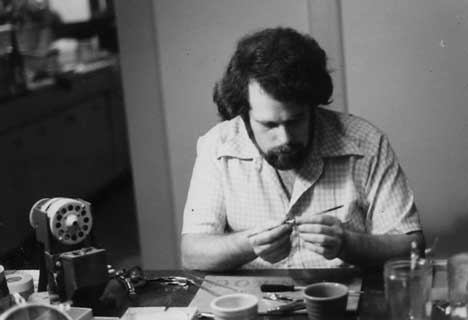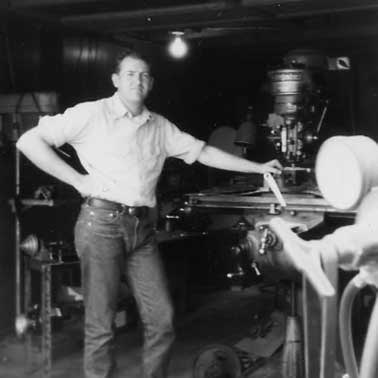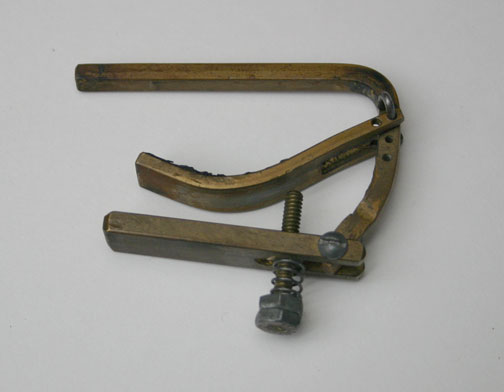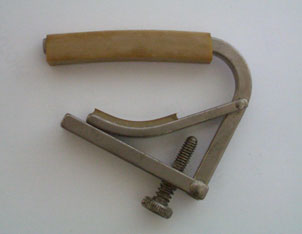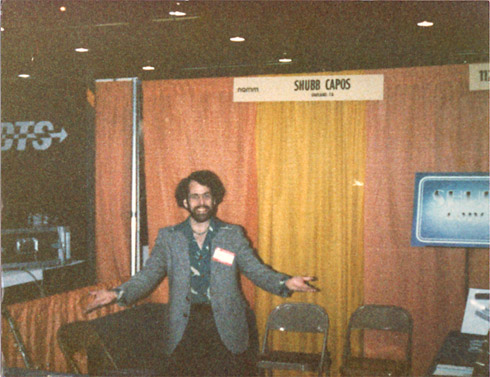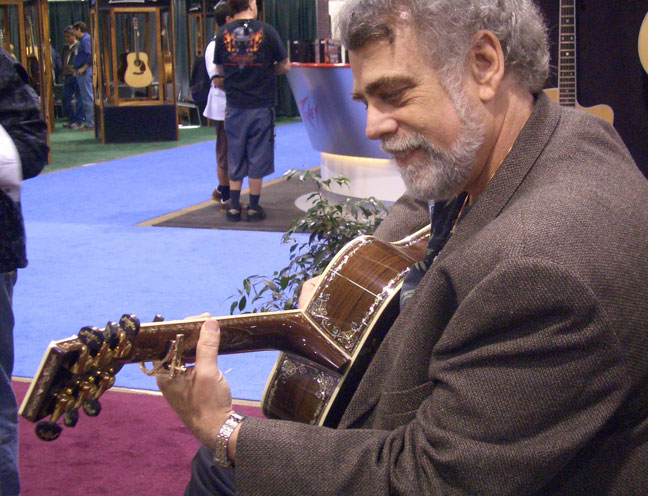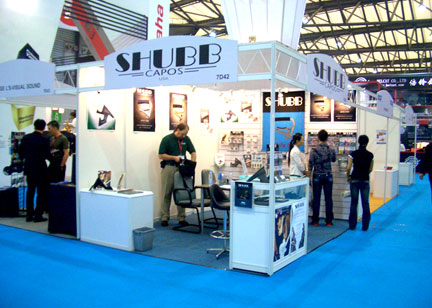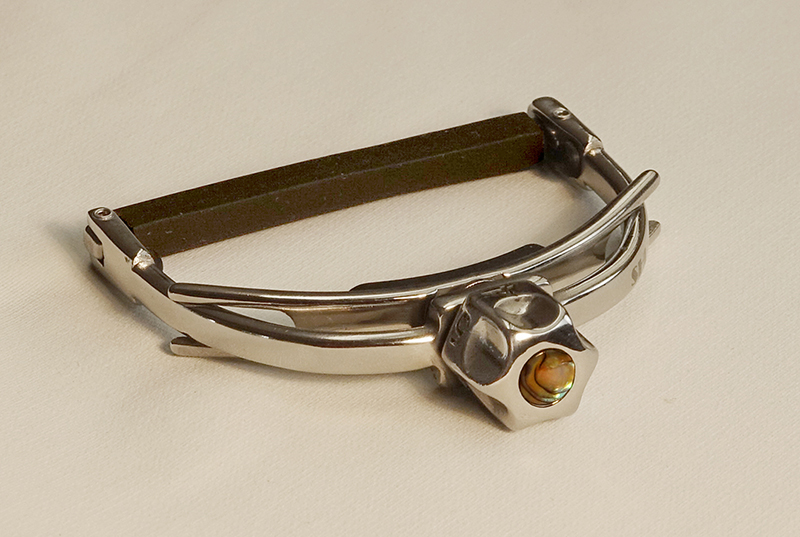A Brief History of Shubb Capos
As told by Rick Shubb
The Shubb Capo company began in California in 1974, when Dave Coontz and I collaborated to design and produce a new fifth string capo for banjo. Before that, I worked as a professional 5-string banjo player and teacher, and Dave was an auto mechanic and a banjo student of mine. One night at his lesson, I was talking about my dissatisfaction with existing methods of capoing the fifth string. I described an idea that I had for a fifth string capo that operated on a lever principle, so that it would provide sufficient pressure for a good tone, and ranted about how I couldn't get anyone in the music products trade interested in making one. Finally, he said "if nobody else will make you one, I will."
The following week he came to his lesson with a fifth string capo true to my description and drawings. It was roughly hewn out of aluminum, and didn't look like much, but it worked well. I used it on a gig that week, and had some ideas for improvements.
For the next few months I would go to Dave's auto shop in Concord two or three nights a week. I'd arrive at 7 PM (closing time), we'd eat at the local Denny's, often sketching new ideas on paper napkins, then work until midnight making improvements on our fifth string capo. I'd test-drive it at gigs, and return with more ideas for improvements.
Eventually I was satisfied with it. It did the job for me onstage, and that was all I had set out to accomplish. But requests from other players prompted us to make a few more. Our course was charted the day we bought a small, second-hand milling machine and set about making a hundred units.
The plan was for me to head for the Southeast and make the bluegrass festival circuit. But before I left, I made a few calls to some of the Bay Area banjoists I knew. My first call went to Jerry Garcia. Jerry and I had been housemates in Palo Alto about ten years earlier, and we still kept in touch. He was having sort of a personal bluegrass renaissance at the time, playing banjo in Old and In the Way, and when I showed him the new fifth string capo, he wanted one immediately. So I installed one on his vintage Weymann banjo, making Jerry our new company's very first customer.
I spent the summer of '74 in the South, making the festival circuit and showing and selling our new fifth string capo. It was very well received, but I returned home with most of those hundred still in a shoe box. For the first few years the capo business was a hobby for both Dave and myself, and didn't yet show signs of becoming more than that.
Around 1975 Dave moved from California to Iowa in search of elbow room. About that same time, I moved to Oregon in search of something or other. For the sake of continuity, we kept the address for the capo sales the same; that of my mother's house in Oakland.
So for awhile, Dave machined fifth string capo parts and farmed in Iowa, I assembled fifth string capos and played in a bluegrass band in Portland, and good ol' Mom stayed home and shipped fifth string capos from Oakland.
Me in Portland assembling 5th string capos, circa 1975
Dave and his Bridgeport milling machine, circa 1976In 1976 I made a trip back to Iowa to see Dave — the first of many such trips — to brainstorm on product ideas, seeking to recapture the magic we'd found at his auto shop in Concord. It worked, and then some. Our plan this time was to design a new guitar capo. We puttered around with that for a while, but then I suggested to Dave that we should tackle another project: a compensated banjo bridge. At that time, banjos all had straight bridges which produced intonation problems on the lower strings in the higher positions. The principle of bridge compensation was already well known, and applied on guitars and mandolins, so we were able to establish the proper compensation within the first few days. Then we spent the next year experimenting with materials, shapes, weights, and measurements to provide the best tone.
in 1977 we introduced the compensated banjo bridge.
Having two products increased our sense of commitment to being in business, and we resumed our efforts toward designing a new type of guitar capo. I returned to Iowa, this time for a three month stay. Three months is a long time for me to be in Iowa, but we had a lot of work to do. I had brought with me every kind of capo I could find, and we laid them all out on Dave's kitchen table. We'd stare at them for hours, pushing them aside temporarily at meal times. They were all variations of some existing device: a C-clamp, a belt, a rubber band, a clothespin, etc. and they all had one thing in common. They put the guitar out of tune. If we couldn't come up with a capo that was better than all of these, we wouldn't make one at all.
The new capo evolved slowly at first. Some of our early prototypes were not too bad, but they weren't the breakthrough we wanted. We were waiting for lightning to strike, and after a while, it did.
It had occurred to Dave that if we added a hinge to the frame of a C-shaped capo, it would provide a quick release that would set our capo apart from others. This would be a desirable feature, but what we didn’t foresee was the sublime closing action this would produce. As it turned out, it would almost magically mimic that complex action of the human hand in not distorting the pitch of the strings. Further trial and error — and a touch of fate — would reveal this true bonanza.
While working on the next prototype, Dave was cutting a notch on the middle piece when the milling machine’s cutter snagged on it, sending the piece flying. He retrieved it to discover that the machine had bent the piece — not at a grotesque angle, but to a smooth but eccentric curve, a bit different from any we had yet tried. He decided to assemble it just as he found it, and then he sent it to me.
I had returned to California by then, and was putting together a new band which was to feature mostly my own tunes. It would have been a good band. But when I received the newest prototype in the mail, opened it, and looked at it, the picture was complete. During the one second it took to snap it onto a guitar, it became clear to me what I would be doing for the rest of my life. I called Dave within minutes, and told him, “This is it. We’ve got it.”
The very first prototype Shubb Capo
A few days later I was back on a plane to Iowa, far sooner than I had planned, for some serious product development. The band was pushed into the background, where it faded and dissolved, and my energy was focused on developing and marketing this new capo.
In late 1979 the Shubb Capo hit the market, and the world, as they say, beat a path to our door. Dave's farming, like my band, moved to the back burner as we tooled up to meet the demand for the new Shubb capo. He created a full scale, dedicated machine shop, becoming an expert machinist in the process. Music for me, while no less of a passion, was no longer a profession as I now had to learn to be a business man. Whether I ever made this transition is open to debate.
The first production model Shubb Capo1981: Dave and I attended our first NAMM show as visitors. McCormick Place, Chicago. What an eye-opener that was as we glimpsed for the first time the frenetic world of the music products business. We had stepped into the fast lane, where we would then remain.
1982: Exhibited at our first NAMM show, Anaheim. Greg Townsend, who worked for me at the time, helped at the booth. We brought our own booth furnishings with us: a card table, folding chairs, a threadbare oriental rug, and a hand-painted sign that sat on an easel proclaiming "Shubb Capos." Pretty folksy. We would turn it up quite a bit in years to come.
There I am on day one of my first, home-made NAMM show booth.
We collaborated with our dear friend John Pearse in 1988 to introduce a new model of guitar steel, the SP1.
In 1990 we made our first trip to Europe, joining with John Pearse and Breezy Ridge Instruments to exhibit at a small music trade show in Rotterdam.
1991: Our first Frankfurt Musikmesse. As an introduction to what was then the world's biggest music trade show, I went as a guest of Saga Musical Instruments. Raul Reynoso came with me, and we brought our instruments. We spent most of the time playing at Saga's booth and demonstrating capos. The following year we returned as part of a USA pavilion, and after that we contracted directly with the Musikmesse for our own booth space. The Frankfurt show became a mainstay of our trade show calendar for the next 24 years.
Somewhat to my own surprise, I found that I had become an expert at database development, first for my own business, and then for other companies. I took a couple of ideas which I had been using for my own purposes, and polished them up into two packaged software products for musicians: GigMaster and SongMaster. These two products expanded our company into an unexpected direction, but like our capos, they were practical solutions to the real-world problems of musicians. I eventually discontinued the software products, as new operating systems did not support the file format used to make them. They were great tools in their time, but that time came to an end.
1995: Introduced the partial capo. C7b.
Many people though that the design of the original Shubb Capo could not be improved upon, but in 1998 we introduced the Shubb DELUXE capo. Made of stainless steel for durability, it featured a roller that replaced the cone-shaped delrin cap, providing smoother operation, reduced wear, and a subtle new mechanical advantage.
1999: Millionth capo sold. Also, 1999 marked the 25th anniversary of the company. To celebrate we joined forces with Saga, who were also celebrating their 25th, to throw a party at the NAMM show in Anaheim. Raul and many of his talented friends provided the music. It had been intended to be a one-time anniversary party, but we enjoyed it so much we made it an annual event. A couple of years after that, John Jorgenson joined the party, and for the past twenty years we have presented John's quintet along with Raul and his band in what has become the NAMM show's most anticipated event.
In 2000 Dave moved from Iowa to Missouri, expanding our production facility in the process. Also in 2000 we introduced the Shubb Transposing Guide (and capo placement guide); a simple but handy slide chart to use for changing keys. In January of 2001 we came out with a new type of guitar slide called the Axys. Developed by Brooks Story, it permits the player to alternate between slide playing and regular fretting -- instantly. And at the 2002 summer show we introduced our new string winder.
2003 saw the introduction of the GS guitar steel, a very innovative product developed by Gary Swallows and refined and produced by us.
Our Friday night events at the NAMM show in Anaheim had been so much fun we decided to host an event at the Summer NAMM show in Nashville, as well. In 2003 we took over the Station Inn to sponsor the Nashville Bluegrass Band, Larry Cordle's band, and Byron Berline. Then in 2004 we were back at the Station Inn again, this time with John Jorgenson. The following year the Summer NAMM show moved to Indianapolis, then to Austin, and we continued to present the John Jorgenson Quintet in concert at each of the new venues, finding the nicest hotel ballroom in each city. Eventually the Summer show returned to Nashville, and our event found a home at the most elegant ballroom of all: the historic Hermitage Hotel. The combination of John's music and the beautiful Hermitage ballroom is pure magic.
A new Shubb partial capo (C8b) was introduced in 2004, along with a revision to the design of our Dobro capo, and a major version upgrade for GigMaster, my software product, still surviving for a while yet. Mid 2004 saw upgraded packaging for almost all of our products.
2004: Two millionth capo sold. We made a special, commemorative solid gold capo, which we displayed at the NAMM show.
Our two-millionth capo looked great on the neck of Martin's millionth guitar.In just four years after moving from Iowa to Missouri, we found that the demand for Shubb Capos was pushing the output limits of our Missouri shop. We faced a difficult decision: could we expand, adding another building, more machines, and more workers? This prospect was daunting. We felt that the size of our workforce was already optimal for the most effecient production, and besides, we weren't getting any younger. Managing a significantly larger workforce was more than we were willing to handle.
So by 2004 we were lookiing at outsourcing as a way to augment our output. We sent parts and drawings to various shops within the USA, but all the quotes we got back would have forced us to nearly double our prices. This showed us just how efficient our inhouse production really was. Eventually we settled on a small machine shop in Korea that we found through a friend in the music trade, and for the next couple of years, they supplied us with just enough parts to allow us to grow. We kept the Missouri shop operating at its maximum output, as it continues to do today, but the additional parts from Korea allowed us to grow by about ten to fifteen percent.
In January of 2005 we introduced Capo Noir; our original capo design in black chrome finish, which has proven to be very popular. A big year for us product-wise, we also introduced the Talon guitar stand, and the Robert Randolph guitar steel.
We made our first trip to China in 2006, exhibiting at Music China. The Shanghai show was still in its infancy then, but it has now become one of the most important trade shows of the year. Organized by Messe Frankfurt, the Shanghai show is a curious blend of German efficiency and Chinese chaos.
Our booth at Shanghai.2008: Three millionth capo sold.
In 2008 Our assembly facility in California moved a few miles from Valley Ford to Rohnert Park, giving us more space and a more practical shipping and receiving location. The Valley Ford location remains in service as warehouse space and my own private office. Also in '08 we introduced the new Shubb Lite ...half the weight of our original capo.
Communications issues with the shop in Korea were making quality control difficult; we needed a new manufacturing partner if we were to continue to grow. I called on my friend Adrian Bagale. I had known him from his stint with Saga, but by this time he had developed a team and a facility of his own in Qingdao, China. With astonishing speed his team in China produced a sample Shubb Capo that was virtually flawless. He then went on to set up a dedicated shop in Qingdao ...our own shop and crew that makes nothing but Shubb Capos, and has the capacity to expand as our needs grow.
In 2011 we introduced our capo for ukulele.
2012: four millionth capo sold. Also in 2012 we spruced up our Lite capo line by making them available in several vivid new colors.
2013 saw one of our most significant product upgrades, as we redesigned our standard line of capos to include the roller mechanism, previously available only on our deluxe models.
As sales continued to grow, the increased production was taken on by our shop in China, since the Missouri shop was already running at maximum output. For the first few years the China crew shipped all the capos to California leaving the final few steps of assembly for the California crew to complete, thereby ensuring continuity and quality control. But the product turned out by our team in Qingdao was so consistently good that eventually this extra step was eliminated, thus enabling us to offer direct shipping from China to wholesalers and retailers in Europe and Asia.
In 2014 we formed a subdivision of the company — Shubb International — to manage global distribution from China, and to better develop and serve the worldwide market for our products.
2015: five millionth capo sold.
I've always been aware of a preference by some players, especially bluegrass players, for the screw-on style of capo; the type that can be stored behind the nut when not in use. Many years ago I had sketched ideas for a screw-on capo that had some unique, desirable features, and I even made a few dozen prototypes. But so far I had not opted to develop this all the way into a marketable product, mainly because of my devotion to the over-center locking action utilized by all my other capos.
Then in 2015 an email exchange with old friend Herb Pedersen inspired me to finish developing this capo and bring it to market. Herb became my beta tester for the new capo I dubbed the Shubb FineTune Capo. It is very different from all my other capos, and it has been very well received by the bluegrass community.
In 2016 the company came to a major turning point. Dave Coontz and I had been 50-50 partners for over forty years, and it was a good partnership. The deal we had made on a handshake back in 1974 was that I would run the business and he would make the capos. But what had been a good balance for so many years had now become unbalanced; the company had continued to grow, and my job of running the business involved more work and responsibility than ever. Meanwhile, our China shop was now accounting for about 80% of our production, while Dave's Missouri shop was producing about 20%. We both knew that the partnership had run its course. We had postponed the decision of a few years, but when we finally got to it, it didn't take more that a few minutes discussion; we both had exactly the same buyout terms in mind. And so as informally as it had begun, the partnership was ended; with a handshake. Only this time it was accompanied by a check, and maybe a tear or two. Now Shubb Capos is a sole proprietorship, and Dave is still manager of the Missouri shop. We remain, as always, the best of friends.
2018: six millionth capo sold
Whatever new directions Shubb Capos might take, you can be sure that one thing will remain unchanged: my absolute dedication to meeting the needs of the musician.

...Rick Shubb
video interview from NAMM's "oral history" project
(me talking about the start of the company)
Well known luthier Frank Ford made a visit to our Valley Ford, CA, facility awhile back and took some pictures. To see his "visit to Shubb Capos," click here.
